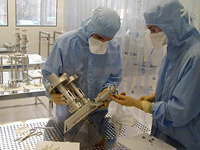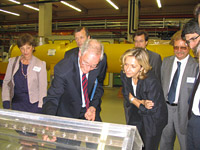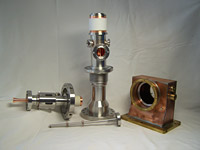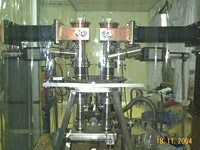 |
 |
|||||||||||||
|
|||||||||||||
|
|||||||||||||
|
During an XFEL (European X-ray laser facility) project meeting, on 2 July at DESY, the main European contributors discussed in-kind contributions for the project. The meeting attendees agreed that France would play a large role in the production of power couplers for the XFEL. The LAL coupler group, at Orsay, will therefore be responsible for following the coupler production, their commissioning and delivery to DESY. To accomplish these tasks, the lab is now pursuing a big effort focused on coupler industrialisation. “This effort will be an exemplary exercise for ILC couplers production,” said Alessandro Variola, head of the LAL group. Radiofrequency power couplers are one of the key elements in the accelerating module for the superconducting linac. They provide RF power to the cavity and interconnect different temperature layers in the module. The coupler technical designs for both the XFEL and ILC involve high quality materials, sophisticated joining techniques and careful handling and assembly in class 10 clean rooms. Optimising the numerous parameters is important, but not enough. For the XFEL, there will be 800 couplers, and there will be 16,000 for the ILC. That means that the actual cost has to be significantly lower than for the previous prototypes. In particular for these mass productions, engineers require equal and reliable quality for all items which implies regular manufacturing processes and extensive industrial production control. Preliminary studies on these processes and on how to reduce the XFEL coupler cost started in March 2006. Three industries were awarded study contracts and are now trying to demonstrate their ability to produce XFEL couplers, applying different technical recipes to reduce the production cost. They also have to define their fabrication process and give an estimation of the price for the full XFEL series. In March 2008, each industry will deliver two prototypes that will be tested at the LAL high power RF station. In 2008, an open call for tender will be launched for the massive production of couplers. “Reducing the unit cost for mass production is a challenging objective that requires tremendous efforts,”says Serge Prat, head engineer and project coordinator at LAL. The cost reduction method, which includes several steps from optimisation of the coupler parts and functions to validation through tested models, has already led to a significant reduction of the number of parts and hence of their junctions. As far as the industrial production is concerned, all processes need to be defined in detail to guarantee the coupler performances in a production series. "An extensive follow-up is needed through regular progress meetings and several exhaustive project reviews at the industrial sites," says Prat. This way, LAL expects a precise estimation of the costs and good confidence in the industrial mass production success. As an example, the joining techniques used in the assembly of couplers require precise procedures and a very clean environment. Adequate patterns must be designed and built to guarantee precise alignment of the different parts. The three industries have already demonstrated their ability to perform such joining on a regular basis. Parallel to these industrial studies, the LAL coupler group is improving the R&D on coupler preparation (including the cleaning, assembly and baking) and on conditioning procedures. Since the cold part of the coupler is integrated to the superconducting cavity, some of the cleaning procedures have been inspired by cavity treatments. The main goal of the team is to find a reliable recipe which will enable them to prepare couplers in the lowest processing time and allow a determinant further reduction of the total cost. Taking advantage of DESY’s initial experience, LAL has developed specific know-how in cleaning and assembling the couplers in its test station. By respecting precise procedures, LAL has succeeded in assembling couplers with very clean surfaces in less than 24 hours of conditioning time as a result of Hassen Jenhani’s PhD work, who is now in charge of different R&D activities at LAL. These techniques will be part of a technology transfer to the industry that will be selected to provide assembled and conditioned couplers for the XFEL. “Industrialisation R&D will be key to ILC success," said Guy Wormser, LAL Director. For XFEL couplers, engineers expect the final production cost to be at least one half smaller than present prototypes cost. These studies will be very helpful for the ILC, where many more couplers will have to be manufactured. For ILC coupler studies, LAL is working closely with KEK and SLAC. The Japanese-French exchange is enhanced and supported by the France-Japan Particle Physics Laboratory and the SLAC coupler group, who recently visited LAL. The three laboratories are now thinking of building a coupler consortium inside the future GDE work package organisation, to maximise collaboration and gather efforts. -- Perrine Royole-Degieux See also the last presentation on coupler industrialisation at LCWS07 (by Serge Prat) |
|||||||||||||
| © International Linear Collider |



